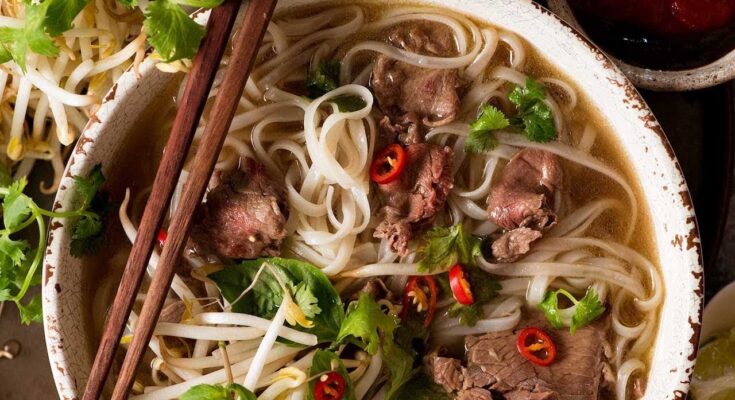Pho Soup Recipe: Pho (pronounced “fuh”) is a warm, soul-soothing Vietnamese noodle soup that combines a fragrant broth, flat rice noodles, herbs, and thinly sliced meat. It’s a dish that has become a global comfort food, appreciated for its balance of flavors and aromas. The key ingredient? A deeply flavorful broth that takes time, love, and care to perfect.
Whether you’ve had pho in a restaurant or you’re new to the dish, making it at home gives you full control over the ingredients, spices, and level of heat. It’s not just soup—it’s an experience in a bowl.
Origin and Cultural Significance
Pho originated in Northern Vietnam in the early 20th century, heavily influenced by both Chinese and French cuisines. Over time, it became a staple street food throughout the country. The North and South have their own distinct styles—northern pho (pho bac) is more about simplicity and clarity, while southern pho (pho nam) brings in more herbs and a slightly sweeter profile.
Pho is more than just a meal; it’s often associated with family gatherings and cozy mornings. Traditionally served for breakfast, pho has now become an all-day delicacy across the globe.
Ingredients You’ll Need
For the Broth
The broth is the star of pho. Here’s what you’ll need:
- 2-3 pounds beef bones (marrow and knuckle bones are ideal)
- 1 large onion, halved
- 1 piece of ginger (about 4 inches), sliced lengthwise
- 3-4 star anise
- 4-5 whole cloves
- 1 cinnamon stick
- 1 tablespoon coriander seeds
- 1 tablespoon fennel seeds
- 1 tablespoon rock sugar or brown sugar
- 1 tablespoon salt
- 3 tablespoons fish sauce
- 10 cups water
Each of these spices adds depth and complexity to the broth, creating that irresistible pho aroma.
For the Noodles and Toppings
- 1 pack of flat rice noodles (Banh Pho)
- 1/2 pound beef sirloin or brisket, thinly sliced
- Bean sprouts
- Fresh herbs (Thai basil, cilantro, mint)
- Lime wedges
- Sliced jalapeños or chili peppers
- Thinly sliced red onions or scallions
These toppings allow you to customize your pho to your taste—whether you like it fresh, spicy, or herbaceous.
Optional Garnishes for Added Flavor
- Hoisin sauce
- Sriracha sauce
- Black pepper
- Thinly sliced garlic
- Beef balls or tendon (for a richer version)
These extras aren’t necessary but can elevate your pho into something truly restaurant-quality.
Kitchen Tools Required
Before diving into cooking, gather these kitchen tools:
- Large stockpot (at least 8-quart)
- Strainer or fine mesh sieve
- Tongs
- Ladle
- Bowls for serving
- Chopsticks and soup spoons
Having the right tools makes the process smoother and helps you replicate the authentic pho experience.
Preparing the Broth – The Heart of Pho
Roasting the Bones and Aromatics
Start by roasting the bones in the oven at 400°F (200°C) for 30-40 minutes. This step enhances the umami flavors and adds depth to your broth.
While that’s going, char the onion and ginger directly over a flame or in a dry pan until blackened. This gives your broth that iconic smoky undertone.
Simmering for Maximum Flavor
Transfer the roasted bones, charred aromatics, and all spices into your stockpot. Add 10 cups of water and bring it to a boil. Then reduce to a gentle simmer and let it go for at least 6–8 hours. Yes, it’s a long wait—but trust me, it’s worth every minute.
Don’t forget to skim off any scum or impurities that rise to the top. This keeps the broth clear and clean-tasting.
Straining and Skimming
Once your broth has simmered to perfection, strain out the solids and discard them. Give the broth a taste—this is where you can adjust salt, sugar, or fish sauce levels. A touch more fish sauce? Go for it. Prefer it less sweet? Dial it back.
Preparing the Noodles and Protein
Choosing the Right Noodles
Soak the rice noodles in warm water for about 30 minutes, then cook them in boiling water for 1–2 minutes, just until tender. Drain immediately and rinse under cold water to stop the cooking.
Be careful not to overcook the noodles—they should be soft but still have a slight chew to them.
Prepping the Meat
Thinly slice the beef sirloin across the grain. If you’re using brisket or tendon, these should be simmered in the broth until tender (2–3 hours), then sliced.
Want to cheat a bit? Freeze the meat slightly before slicing—it makes getting those paper-thin slices much easier.
Assembling Your Bowl of Pho
Layering the Ingredients
Now comes the fun part—building your perfect bowl of pho! Start by adding a generous handful of cooked rice noodles to the bottom of each bowl. Next, lay your thinly sliced raw beef on top. Don’t worry, the hot broth will cook it almost instantly when poured over.
Then, begin layering in your favorite toppings—bean sprouts, Thai basil, cilantro, and a few slices of chili if you like heat. Add in a couple of slices of red onion or scallions for that extra kick.
This layering process allows the hot broth to slowly infuse each element with flavor. It’s not just a dish—it’s a personalized bowl of deliciousness.
Pouring the Broth and Serving
Ladle the steaming broth directly over the noodles and meat. The high heat of the broth cooks the raw beef to a tender perfection and slightly wilts the herbs, unlocking their aromas. Make sure to pour enough broth to submerge the ingredients well—this soup is meant to be slurped!
Serve with lime wedges, hoisin sauce, and sriracha on the side. Let your guests season their pho to taste. Some like it sweet and spicy; others prefer it simple and clean.
The beauty of pho lies in its adaptability—it’s your bowl, your rules.
Tips for the Perfect Pho at Home
- Roast the bones – Don’t skip this step! Roasting adds depth and body to your broth.
- Char the aromatics – Charring the onion and ginger releases smoky flavors that are essential for authentic pho.
- Simmer low and slow – The best broth takes hours. Rushing this step will leave your soup flat and lifeless.
- Skim often – Keeping the broth clear and clean-tasting depends on removing impurities regularly.
- Use fresh herbs – Basil, cilantro, and mint should be fresh and added just before serving.
- Balance your flavors – Adjust salt, sugar, and fish sauce carefully at the end for the perfect umami blend.
- Thinly slice the meat – Paper-thin slices cook quickly and absorb the broth beautifully.
Remember, pho is as much about the process as it is about the final product. The aroma that fills your kitchen during simmering is just a bonus.
Common Mistakes to Avoid
Even experienced home cooks can stumble when it comes to making pho. Here’s what to avoid:
- Using store-bought broth: This shortcut sacrifices the complexity and richness of real pho. Invest the time—it’s worth it.
- Overcooking the noodles: Mushy noodles ruin the texture of pho. Keep them al dente.
- Not straining the broth properly: Leftover bits and bones will cloud your soup and muddy the flavor.
- Skipping the skimming process: Skipping this results in a greasy, impure broth.
- Adding all garnishes at once: Let each person customize their bowl. Pho is meant to be a personalized experience.
If you’ve ever had pho that tasted bland or overly greasy, chances are one of these common errors was at play.
FAQs about Pho Soup Recipe
What is Pho?
Pho (pronounced “fuh”) is a classic Vietnamese soup consisting of broth, rice noodles (banh pho), herbs, and meat, usually beef (pho bo) or chicken (pho ga). It’s renowned for its savory flavors and aromatic spices, making it a beloved dish worldwide.
What are the key ingredients in Pho?
The soul of pho lies in its broth, which typically includes bones (beef or chicken), onions, ginger, star anise, cinnamon, cloves, cardamom, and coriander seeds. Fresh herbs like cilantro, basil, and green onions, along with lime wedges and bean sprouts, are added for extra zest and crunch.
How long does it take to make Pho?
The cooking time for pho can vary. A traditional broth simmers for several hours (3-6 hours) to extract deep flavors from the bones and spices. However, for a quick weekday meal, there are speedier versions that can be ready in about an hour using ready-made broths as a base.
Can Pho be made vegetarian?
Absolutely! For a vegetarian version, swap the bone broth for a rich vegetable broth and use spices generously. Tofu can be used instead of meat to keep the protein component hearty. Don’t skimp on the herbs and lime for that authentic pho flavor.
Is Pho healthy?
Pho can be very nutritious. It’s typically low in fat and packed with fresh ingredients. The broth is hydrating, and the herbs provide essential vitamins and minerals. For a healthier bowl, opt for lean cuts of meat and go easy on the noodles.
What’s the best way to serve Pho?
Pho is best served hot with the broth poured over the noodles and meat. Offer condiments like hoisin sauce, sriracha, lime wedges, fresh herbs, and sliced jalapeños on the side, so everyone can customize their bowl to taste.
How do you properly eat Pho?
Dive in with chopsticks in one hand for the solids and a spoon in the other for the broth. It’s customary to slurp the noodles directly from the bowl—it’s not only accepted, it’s encouraged! Enjoying pho is both a feast for the taste buds and a comforting, sensory experience.
Conclusion
Pho isn’t just food—it’s a feeling. From the aromatic steam rising from the bowl to the rich, layered flavors in every spoonful, pho delivers warmth, comfort, and joy. Yes, it takes time to prepare, but the reward is a deeply satisfying, restaurant-quality soup that you can make in your own kitchen.
Once you’ve mastered the basics, you can start experimenting with different proteins (like chicken or tofu), spices, or even broth bases. Pho is endlessly customizable, which is why it’s loved around the world.
Now that you’ve got the recipe and all the pro tips, it’s time to put on your apron and start simmering. Trust me—once you make pho from scratch, there’s no going back.



